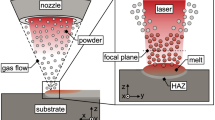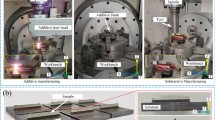Abstract
Recently, the commercialization of hybrid machine tools that combine directed energy deposition (DED) additive manufacturing (AM) technology and subtractive manufacturing (SM) has rapidly progressed. This technology trend has been developed to meet the market demand for processing quality (precision) and productivity, and to produce products such as lightweight parts, and complex and special functional parts, as well as to facilitate mold production and part repair. Compared to SM technology, metal AM technology has limitations in terms of surface quality and shape accuracy. Therefore, post-processing is necessary for the AM output. Laser-assisted machining (LAM) is an innovative hybrid technique in which surface quality and productivity can be improved by enhancing the machinability of difficult-to-cut materials. LAM studies have mainly been performed on titanium alloys, nickel based alloys and ceramic materials. However, except for ceramics, no high-strength material studies have been conducted to analyze the LAM process machining characteristics of workpieces fabricated by AM process. Therefore, in this study, LAM is applied to post-processing of output fabricated by AM of Ti-6Al-4V. DED device was developed using metal powder feeder and a laser. The Ti-6Al-4V workpieces were successfully fabricated through many tests. The cutting depth for LAM was selected through thermal analysis for LAM of the fabricated workpiece. Compared to the case of traditional machining without preheating, machining characteristics in LAM experiments were analyzed and property testing was performed.



















Similar content being viewed by others
References
Ning, J., Sievers, D. E., Garmestani, H., et al. (2019). Analytical modeling of in-process temperature in powder feed metal additive manufacturing considering heat transfer boundary condition. International Journal of Precision Engineering and Manufacturing-Green Technology. https://doi.org/10.1007/s40684-019-00164-8
Nguyen, C. H. P., Kim, Y., & Choi, Y. (2019). Design for additive manufacturing of functionally graded lattice structures: a design method with process induced anisotropy consideration. International Journal of Precision Engineering and Manufacturing-Green Technology. https://doi.org/10.1007/s40684-019-00173-7
Woo, Y., Han, S., Oh, I., et al. (2019). Control of directed energy deposition process to obtain equal-height rectangular corner. International Journal of Precision Engineering and Manufacturing,20, 2129–2139.
Chua, B., Lee, H., Ahn, D., et al. (2019). A study on activation algorithm of finite elements for three-dimensional transient heat transfer analysis of directed energy deposition process. International Journal of Precision Engineering and Manufacturing,20, 863–869.
Kim, H., Cha, M., Kim, B. C., et al. (2019). Maintenance framework for repairing partially damaged parts using 3D printing. International Journal of Precision Engineering and Manufacturing,20, 1451–1464.
Liu, S., & Shin, Y. C. (2019). Additive manufacturing of Ti6Al4V alloy: A review. Materials and Design, 164, 107552.
Pragana, J. P. M., Cristino, V. A. M., Bragança, I. M. F., et al. (2019). Integration of forming operations on hybrid additive manufacturing systems based on fusion welding. International Journal of Precision Engineering and Manufacturing-Green Technology. https://doi.org/10.1007/s40684-019-00152-y
Campatelli, G., Montevecchi, F., Venturini, G., et al. (2019). Integrated WAAM-subtractive versus pure subtractive manufacturing approaches: An energy efficiency comparison. International Journal of Precision Engineering and Manufacturing-Green Technology. https://doi.org/10.1007/s40684-019-00071-y
Park, E., Kim, D. M., Park, H. W., et al. (2019). Evaluation of tool life in the dry machining of inconel 718 parts from additive manufacturing (AM). International Journal of Precision Engineering and Manufacturing. https://doi.org/10.1007/s12541-019-00275-x
Rao, X., Zhang, F., Lu, Y., Luo, X., Ding, F., et al. (2019). Analysis of diamond wheel wear and surface integrity in laser-assisted grinding of RB-SiC ceramics. Ceramics International, 45, 24355–24364.
Ma, Z., Wang, Z., Wang, X., & Yu, T. (2020). Effects of laser-assisted grinding on surface integrity of zirconia ceramic. Ceramics International, 46, 921–929.
Song, H., Li, J., Dan, J., Ren, G., Xiao, J., et al. (2019). Experimental analysis and evaluation of the cutting performance of tools in laser-assisted machining of fused silica. Precision Engineering, 56, 191–202.
Park, C. I., Wei, Y., Hassani, M., Jin, X., Lee, J., & Park, S. S. (2019). Low power direct laser-assisted machining of carbon fibre-reinforced polymer. Manufacturing Letters, 22, 19–24.
Guerrini, G., Lutey, A. H. A., Melkote, S. N., & Fortunato, A. (2018). High throughput hybrid laser assisted machining of sintered reaction bonded silicon nitride. Journal of Materials Processing Technology, 252, 628–635.
Woo, W. S., & Lee, C. M. (2018). A study on the machining characteristics and energy efficiency of Ti-6Al-4V in laser-assisted trochoidal milling. International Journal of Precision Engineering and Manufacturing-Green Technology, 5(1), 37–45.
Woo, W. S., & Lee, C. M. (2018). A study on the optimum machining conditions and energy efficiency of a laser-assisted fillet milling. International Journal of Precision Engineering and Manufacturing-Green Technology, 5(5), 593–604.
Kim, E. J., & Lee, C. M. (2018). A study on the machining characteristics of curved workpiece using laser-assisted milling with different tool paths in Inconel 718. Metals, 8, 968.
Yu, J., Rombouts, M., Maes, G., & Motmans, F. (2012). Material properties of Ti6Al4V parts produced by laser metal deposition. Physics Procedia, 39, 416–424.
Jeong, W. J., Kwon, Y. S., & Kim, D. S. (2015). Development of a metal 3D printer using laser powder deposition and process optimization for fabricating titanium alloy parts. Journal of Korean Society of Laser Processing, 18, 1–5.
Seo, J. Y., Yoon, H. S., Lee, K. Y., & Shim, D. S. (2018). Study on effects of direct laser melting process parameters on deposition characteristics of AlSi12 powders. Transactions of Materials Processing, 27, 314–322.
Sim, M. S., & Lee, C. M. (2016). Determination of optimal laser power according to the tool path inclination angle of a titanium alloy workpiece in laser assisted machining. International Journal of Advanced Manufacturing Technology, 83, 1717–1724.
Brecher, C., Rosen, C. J., & Emonts, M. (2010). Laser-assisted milling of advanced materials. Physics Procedia,5, 259–272.
Acknowledgements
This work was supported by the Technology Innovation Program (No. 20002796, Development of hybrid manufacturing system technologies based on CPS for 3D Printing of high melting point alloys) funded by the Ministry of Trade, Industry & Energy (MOTIE, Korea) and the National Research Foundation of Korea (NRF) grant funded by the Korea government (MSIT) (Nos. 2019R1A2B5B03070206, 2019R1A5A808320111).
Author information
Authors and Affiliations
Corresponding author
Additional information
Publisher's Note
Springer Nature remains neutral with regard to jurisdictional claims in published maps and institutional affiliations.
Rights and permissions
About this article
Cite this article
Woo, WS., Kim, EJ., Jeong, HI. et al. Laser-Assisted Machining of Ti-6Al-4V Fabricated by DED Additive Manufacturing. Int. J. of Precis. Eng. and Manuf.-Green Tech. 7, 559–572 (2020). https://doi.org/10.1007/s40684-020-00221-7
Received:
Revised:
Accepted:
Published:
Issue Date:
DOI: https://doi.org/10.1007/s40684-020-00221-7




